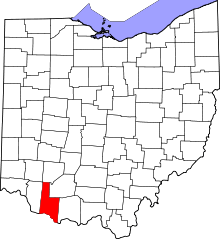Higginsport, Ohio
| Higginsport, Ohio | |
|---|---|
| Village | |
 Location of Higginsport, Ohio | |
| Coordinates: 38°47′23″N 83°58′1″W / 38.78972°N 83.96694°WCoordinates: 38°47′23″N 83°58′1″W / 38.78972°N 83.96694°W | |
| Country | United States |
| State | Ohio |
| County | Brown |
| Area[1] | |
| • Total | 0.29 sq mi (0.75 km2) |
| • Land | 0.25 sq mi (0.65 km2) |
| • Water | 0.04 sq mi (0.10 km2) |
| Elevation[2] | 512 ft (156 m) |
| Population (2010)[3] | |
| • Total | 251 |
| • Estimate (2012[4]) | 248 |
| • Density | 1,004.0/sq mi (387.6/km2) |
| Time zone | Eastern (EST) (UTC-5) |
| • Summer (DST) | EDT (UTC-4) |
| ZIP code | 45131 |
| Area code(s) | 937 |
| FIPS code | 39-35168[5] |
| GNIS feature ID | 1064835[2] |
Higginsport is a village in Brown County, Ohio, United States, along the Ohio River. The population was 251 at the 2010 census.
History
The town of White Haven was laid out in 1804, but the attempt at a settlement did not prove successful.[6] In 1816, the town was replatted and named in honor of Colonel Robert Higgins, a Revolutionary War veteran and early settler in the area.[7]
White burley tobacco was first grown in Higginsport in 1864 from seed brought in from Kentucky.[8]
Gallery
-
Higginsport corporation limit sign.
-
Looking east on Columbia Street (US Highway 52) in Higginsport.
Geography
Higginsport is located at 38°47′23″N 83°58′1″W / 38.78972°N 83.96694°W (38.789585, -83.967055).[9]
According to the United States Census Bureau, the village has a total area of 0.29 square miles (0.75 km2), of which 0.25 square miles (0.65 km2) is land and 0.04 square miles (0.10 km2) is water.[1]
Demographics
2010 census
As of the census[3] of 2010, there were 251 people, 104 households, and 65 families residing in the village. The population density was 1,004.0 inhabitants per square mile (387.6/km2). There were 138 housing units at an average density of 552.0 per square mile (213.1/km2). The racial makeup of the village was 96.8% White, 0.4% Native American, 0.8% from other races, and 2.0% from two or more races. Hispanic or Latino of any race were 1.2% of the population.
There were 104 households of which 26.9% had children under the age of 18 living with them, 44.2% were married couples living together, 11.5% had a female householder with no husband present, 6.7% had a male householder with no wife present, and 37.5% were non-families. 32.7% of all households were made up of individuals and 19.2% had someone living alone who was 65 years of age or older. The average household size was 2.41 and the average family size was 2.94.
The median age in the village was 44.5 years. 19.5% of residents were under the age of 18; 10.5% were between the ages of 18 and 24; 20.4% were from 25 to 44; 31.2% were from 45 to 64; and 18.7% were 65 years of age or older. The gender makeup of the village was 49.0% male and 51.0% female.
2000 census
As of the census[5] of 2000, there were 291 people, 114 households, and 77 families residing in the village. The population density was 1,305.0 people per square mile (510.7/km²). There were 134 housing units at an average density of 600.9 per square mile (235.2/km²). The racial makeup of the village was 99.31% White, and 0.69% from two or more races. Hispanic or Latino of any race were 0.34% of the population.
There were 114 households out of which 29.8% had children under the age of 18 living with them, 58.8% were married couples living together, 8.8% had a female householder with no husband present, and 31.6% were non-families. 30.7% of all households were made up of individuals and 13.2% had someone living alone who was 65 years of age or older. The average household size was 2.55 and the average family size was 3.18.
In the village the population was spread out with 25.8% under the age of 18, 5.8% from 18 to 24, 27.1% from 25 to 44, 23.7% from 45 to 64, and 17.5% who were 65 years of age or older. The median age was 40 years. For every 100 females there were 92.7 males. For every 100 females age 18 and over, there were 77.0 males.
The median income for a household in the village was $32,000, and the median income for a family was $37,188. Males had a median income of $30,625 versus $20,000 for females. The per capita income for the village was $10,989. About 9.6% of families and 11.5% of the population were below the poverty line, including 10.5% of those under the age of eighteen and 8.8% of those sixty five or over.
See also
- List of cities and towns along the Ohio River
References
- ↑ 1.0 1.1 "US Gazetteer files 2010". United States Census Bureau. Retrieved 2013-01-06.
- ↑ 2.0 2.1 "US Board on Geographic Names". United States Geological Survey. 2007-10-25. Retrieved 2008-01-31.
- ↑ 3.0 3.1 "American FactFinder". United States Census Bureau. Retrieved 2013-01-06.
- ↑ "Population Estimates". United States Census Bureau. Retrieved 2013-06-17.
- ↑ 5.0 5.1 "American FactFinder". United States Census Bureau. Retrieved 2008-01-31.
- ↑ The History of Brown County, Ohio: Containing a History of the County, Its Townships, Towns, Churches, Schools, Etc. Higginson Book Company. 1883. p. 472.
- ↑ Karle, Tina. "120 Waterfall Hikes Around Cincinnati Ohio". Lulu.com. p. 14. Retrieved 27 November 2013.
- ↑ Federal Writers' Project (1996). "The WPA Guide to Kentucky". University Press of Kentucky. p. 51. Retrieved 24 November 2013.
- ↑ "US Gazetteer files: 2010, 2000, and 1990". United States Census Bureau. 2011-02-12. Retrieved 2011-04-23.
| |||||||||||||||||||||||||||||


